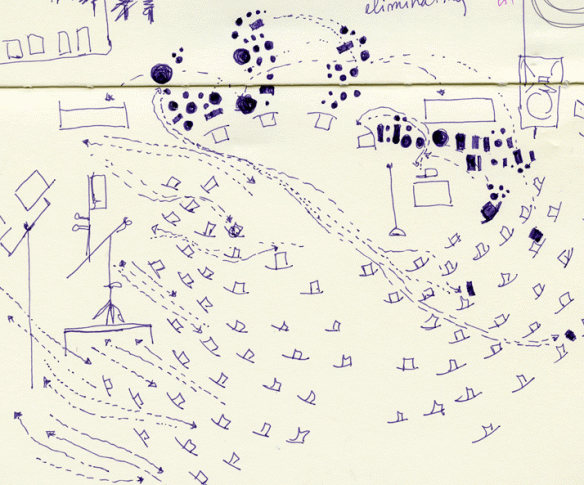“…pinioned…mortised…weighted down…” A few words plucked from the subsequent paragraph of Nancy’s essay wherein he describes the space in Caravaggio’s painting – heavy and sombre, the imprisonment of grief, the immobility of death. Yet this is death beautifully written – in Nancy’s poetic mix of philosophy and prose.
Monthly Archives: February 2011
presence
I have taken Nancy’s words out of their context – for no other reason than their beauty – and placed them into a sequence on their own. In the original, Nancy discusses the viewer’s place and relationship to the death represented there in Caravaggio’s painting, (“The Death of the Virgin”) but to me, the words may speak of any death.
nothing
indiscretion
Four phrases from the second paragraph of Nancy’s essay “On the Threshold” are the source for this sequence of drawings. I like Nancy’s words – how we invade the space, engage with an image – and how it in turn seizes us, attracts us, pulls us in.
in fact that
a manner simple
“We are there in a manner older and simpler than any movement, displacement or penetration.” (Jean-Luc Nancy)
One of the fascinating creatures of mythology is the sphinx – a hybrid of human, animal and bird. She has appeared in art well beyond her ancient beginnings. An enigmatic figure, sometimes considered malevolent and at others benevolent, she too stands at the threshold – between life and death, the old and the new. It is her liminality that appeals to me, that space “neither inside nor outside.”
there
The M-Webster dictionary gives the following definitions for threshold
“…a physical marker, like the plank, stone or piece of timber that lies under a door. The end or boundary, the place or point of entering or beginning; the point at which a physiological or psychological effect begins to be produced. A level, point, or value above which something is true or will take place and below which it is not or will not.”
The point of interest for me is that portion of that definition that speaks of the “end or boundary, the point of entering or beginning,” that ambiguous point that is both beginning and end, true and not true, real and unreal – and one which can be considered physically, psychologically or symbolically.
I think perhaps Nancy, with his poetic play on words, intimates the possibilities of the word – threshold – and places our involvement with the image in these multiple realms of experience, for (I have found) Nancy never leaves a word with one bound meaning, but enjoys the layered and shifting sense that each word can invoke.
white threshold
This set of images represent a re-interpretation of the opening phrases of Jean-Luc Nancy’s essay “On the Threshold,” from his text The Muses. Nancy examines a painting by Caravaggio, “The Death of the Virgin,” (1605-6) and utilizes the complex spaces, colors and forms of this work to explore ideas of the relationship of viewer to image.
I have chosen to do this transcription in white with tones of grey, in order to examine this in-between space, this threshold.
intimate/alternate cartography
 This past weekend, I attended a symposium, called Cartographic Exploits at the Centre for Digital Media, organized in conjunction with the PUSH Festival. During the moderated panel discussion which followed artists’ presentations, I thought I would engage in some mapping of spaces. The little drawing here marks a rough plan of the seating, the dots and rectangles mark moments of speaking and the dotted lines trace the movement of people during a half-hour of the discussion.
This past weekend, I attended a symposium, called Cartographic Exploits at the Centre for Digital Media, organized in conjunction with the PUSH Festival. During the moderated panel discussion which followed artists’ presentations, I thought I would engage in some mapping of spaces. The little drawing here marks a rough plan of the seating, the dots and rectangles mark moments of speaking and the dotted lines trace the movement of people during a half-hour of the discussion.
We encountered some exceedingly interesting artists there doing extraordinary work – like the French duo from Project in Situ, who created an intimate theatre piece where participants were invited to re-examine their relationship to the city while touring blindfolded and with the aid of a guide – three guides in fact: an artist, a visually handicapped person and a dancer. What came to mind immediately was the vulnerability, the need for trust between the blindfolded traveller and the guide and the subsequent new relationship which developed as a consequence of these “unequal” pairings. Another fantastic artist – a traveller, a wanderer, who presented at the symposium was Volker Gerling whose poetic photographic flip-book portraits of people encountered during his travels were captivating to see.



